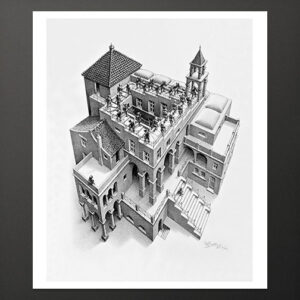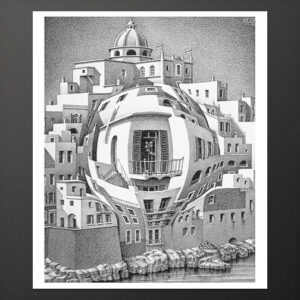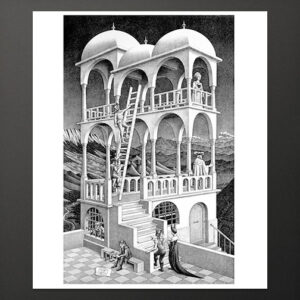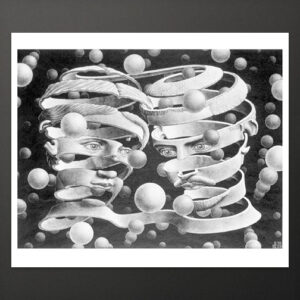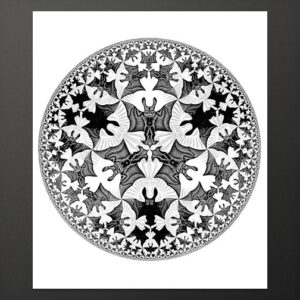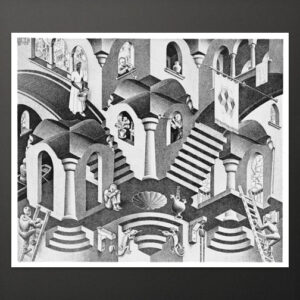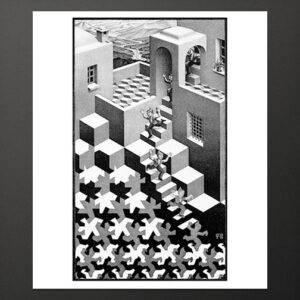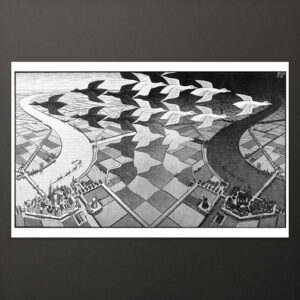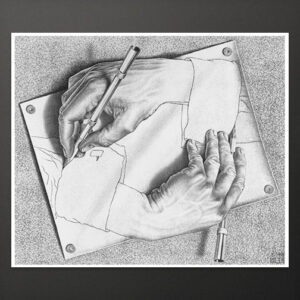-
Ascending and Descending, lithograph, 1960. "The endless staircase, that is the main motif of this imagery, was taken from an article by L.S. Penrose in the February 1958 issue of the British Journal of Psychology. A rectangular courtyard is bordered by a building that has an endless staircase as a roof covering. The inhabitants of this housing complex may well be monks, members of an unknown sect. It may be their ritual duty to climb this staircase for a few hours every day. When they are tired, they are apparently allowed to turn around and descend instead of climbing. But both directions, although meaningful, are equally restless. Two recalcitrant individuals refuse for the time being to participate in this exercise. They think what they want about it, but perhaps sooner or later they will see their error." ~ M.C. Escher, Grafiek en Tekeningen. Printed in black and white on poster paper. Paper size : 55 x 65 cm. Image size approx : 44,5 x 54 cm. Packaged in cardboard tube.
-
Printed in black and white on poster paper. Packaged in cardboard tube. Paper size : 55 x 65 cm. Image size approx : 46,5 x 58,7 cm.
-
Belvedere, lithograph, 1958 "In the foreground, bottom left, is a sheet of paper on which the edges of a cube have been drawn. Two circles indicate the places where edges cross each other. Which edge is in front, which is behind? Front and back at the same time is in a three -dimensional world is not possible and therefore cannot be depicted. But an object can be drawn that represents a different reality from above than from below. The boy sitting on the bench has such a cube-like absurdity in his hands. He looks thoughtfully at the impossible object and is apparently unaware that the belvedere behind him has been built in the same impossible way. On the floor of the lower platform, i.e. indoors, there is a ladder, along which two people are busy climbing. But when they arrive one floor higher, they are back in the open air and have to enter the building again. Is it any wonder that no one in the group cares about the fate of the prisoner in the basement, who puts his head through the bars, whimpering?" ~ M.C. Escher, Grafiek en Tekeningen. Printed in black and white on 170 gram paper. Paper size : 55 x 65 cm. Image size approx : 35 x 55 cm. Shipped in cardboard tube.
-
Bond of Union, lithograph, 1956. "Two spirals flow into each other and depict a woman's head on the left and a man's on the right. Like an endless ribbon, their foreheads intertwined, they form a unity. The spatial effect is enhanced by floating spheres, in front of, in and behind the hollow effigies." ~ M.C. Escher, Grafiek en Tekeningen. Printed in black and white on 170 gram paper. Paper size 65 x 55 cm. Image size approx : 58 x 43,7 cm. Shipped in cardboard tube.
-
Circle Limit IV (Heaven and Hell or Angels and Devils), woodcut of 2 blocks printed, 1960. "Here too, the components shrink from the inside out. The six largest, three white angels and three black devils, are arranged radially around the center. The disc is divided into six sectors, in which the angels on a black background and the devils on a white background alternately dominate. Heaven and hell alternate six times." ~ M.C. Escher, Grafiek en Tekeningen. Printed in black and white on 170gram paper. Paper size : 55 x 65 cm. Image size approx: 49,2 x 49,2 cm. Packaged in cardboard tube.
-
Convex and Concave, lithograph, 1955. "Next to each other are three houses with a cross vault as a roof. The left one is seen externally, the right one internally and the middle one optionally from inside or outside. There are several such inversions on this picture shown; one of them is described here. There are two boys playing the flute. One on the left looks down on the roof of the middle house; if he climbs through his window he can jump onto the roof below. If he then jumps down again, he ends up one floor lower on the dark floor in front of the house. However, the right flute player sees that same cross vault above his head as a roof before him there is no floor, but a fathomless abyss." ~ M.C. Escher, Graphics and Drawings. Printed in black and white on 170 grams poster paper. Paper size : 55 x 65 cm. Image size : 56 x 47 cm. Packaged in cardboard tube.
-
Cycle, lithograph, 1938. "At the top right, a cheerful boy emerges from his house. As he runs down the stairs, he loses his spatiality and ends up in a pattern of flat, gray, white and black peers. Counterclockwise upwards, these simplify into diamonds. The effect of depth is regained in the combination of three diamonds that are reminiscent of a cube. The cube connects to the house from which the boy emerges again. The floor of a terrace is covered with the same well-known pattern of diamond-shaped tiles. The view above is intended as a maximum of three-dimensional naturalness, while the periodic pattern from below shows a maximum of two-dimensional consistency." ~ M.C. Escher, Grafiek en Tekeningen. Printed in black and white on poster paper. Paper size : 55 x 65 cm. Image size approx : 32 x 54,5 cm. Packaged in cardboard tube.
-
Day and Night, woodcut of 2 blocks, 1938. "Gray rectangular fields develop upwards into silhouettes of white and black birds; the black ones fly to the left, the white ones to the right as two oppositely directed formations. On the left, the white ones flow into each other and unite into a daytime sky and landscape. On the right, the black ones merge into night. The day and night landscapes are each other's mirror images, which unite by means of gray fields, from which the birds develop again." ~ M.C. Escher, Grafiek en Tekeningen. Printed in black and white on poster paper. Paper size: 86,7 x 55 cm. Image size approx 78,5 x 45,5 cm. Packaged in cardboard tube.
-
Drawing Hands, lithograph, 1948. "A piece of paper is pinned to a surface with four drawing pins. A right hand is busy sketching the sleeve of a shirt on that drawing paper. The hand has not yet finished its work at that spot, but somewhat further to the right it has a left hand protruding from the sleeve, already depicted in such detail that it rises from the plane and in turn, like a living body part, outlines the sleeve from which the right hand emerges." M.C. Escher, Grafiek en Tekeningen. Printed in black and white on 170 gram paper. Paper size : 65 x 55 cm. Image size approx : 54,5 x 46 cm. Packaged in cardboard tube.

